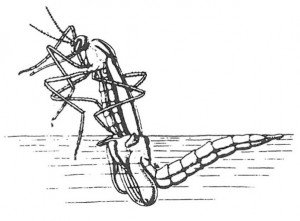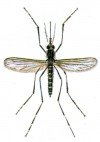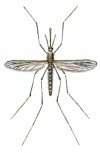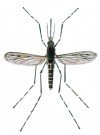
The mosquito larvae and pupae live in water. The species that are particularly troublesome in Denmark do not breed in lakes, ponds, streams or rivers, which are always water-bearing. However, they breed in ditches and puddles, which occasionally dry out. These are mosquitoes of the genus Aedes. In Denmark, they are divided into two types according to their habitat: Mosquitoes that live in beach meadows and mosquitoes that live in forests.

The forest mosquitoes lay their small, shiny eggs on low, moist places in the forest floor between the leaves. Here the eggs will lie during the rest of the summer and during the winter. They hatch in the spring when the snow melts and the hollows form puddles. They hatch in late March. The larvae feed on the finely ground organic matter and microorganisms that are found in the water. It takes the larvae a few months to become adults. Pupation also happens in the puddle, and finally, the mosquitoes can leave the puddle as adults. This usually happens in mid-May. There is only one generation of these mosquitoes every year.
The life cycle of the beach meadow mosquitoes is similar to that of the forest mosquitoes; however, they lay their eggs on low, moist places in beach meadows and in reed swamps, where puddles of brackish water are formed when water levels rise. There may be several generations of beach meadow mosquitoes each year.

“Mosquito years”. The Aedes mosquitoes’ development is a race against time because the puddles risk drying up. If the early summer is quite dry, almost all puddles in the forests will dry up before the mosquitoes are adults, resulting in few mosquitoes that year. However, years with high quantities of precipitation during the winter and spring – as well as high groundwater level in the spring notoriously result in many Aedes mosquitoes in the Danish forests. The Aedes mosquitoes, which live in the beach meadows, depend on the correlation between the groundwater level and high tides, which determine how many mosquitoes are hatched.
The mosquito eggs can lie and wait for several years, and some of them do not hatch the first time they are submerged into water. In this way, the mosquitoes do not put all their eggs in one basket. Even if all the puddles should dry up prematurely one year, there are eggs diapause, which guarantees that mosquito larva, will hatch in the puddle the next year.

Mosquitoes of the genus Anopheles belong to the species of mosquitoes that lay their eggs directly on the water and their larvae prefer habitats with vegetation.
The, Culiseta annulata mosquito lays its eggs on the water surface in boat-shaped clutches, and because its larvae are not bothered by pollution, they are often found in, water barrels, clogged gutters, etc.
Mosquitoes bites in the winter. Large numbers of fertilized females of the Culiseta annulata genus often take to sheds and cellars during the winter. If their habitats are heated during the winter, they become active and are likely to bite humans. The bites can be mistaken for bedbug bites.
How far do mosquitoes fly? If Aedes mosquitoes in forests bother you, you can assume that the puddle or ditch from which they have hatched is located within a few hundred meters. They rarely fly further away from their habitat. The Aedes mosquitoes that are hatched in beach meadows, on the other hand, often fly several kilometers away from their habitat. Naturally, you are more likely to be bothered by mosquitoes if you are near their breeding places, however, mosquitoes from the beach meadows at Køge Bay, fly in most of Copenhagen.




